9 is a computer
animated film, directed by animator Shane Acker, released on September 9th,
2009 (09/09/09). That right there is already an interesting marketing decision,
in a movie that is loaded with unusual symbolism and a story that involves
alchemy, occultism, visual discussions on the darker sides of religion,
government, and science, as well as the discussion on what life is. Or, it
could just be a kinda cool, highly underrated animated movie with a stellar
voice cast and a fantastic knack for good storytelling and world detail. A lot
of film critics said the film lacked substance. I don’t know what version of
the film they were watching, but 9
has a lot more too it than meets the eye.
In the story, nine animated dolls (or “Stitchpunks”), awaken
in a post-apocalyptic world where machines have wiped out humanity following
war and poisonous annihilation. Though divided in their beliefs and
friendships, the nine Stitchpunks have to band together to defend themselves
from the machines, learn the truth of how they came to be, and decide what
course the future shall take.
In the background, sprinkled throughout the film, we learn
an unnamed scientist (Alan Oppenheimer) was tasked with creating a new form of
technology to use as a weapon. He creates the Fabrication Machine, a cycloptic
robot, using his own intellect to power it. The robot is shown to have been
childlike, but could learn and think for itself. The ruling Chancellor of the
Scientist’s country, seized the Machine, and placed it in a factory to build
war machines in its own image. But, the power and pain put upon the Machine
causes it be corrupted, and it turns on humanity, wiping them out using
poisonous gas.
As society collapsed, the Scientist used alchemy to transfer
parts of his soul into the Stitchpunks, sending them off into the unknown,
hopefully to save humanity. The Scientist used an alchemic talisman to perform
his transmutations, and died after creating 9, leaving a recorded message for
him, on how to defeat the Machine using the talisman, and bring life back to
the dead world.
The movie appears to be set in an alternate history where
World War II, or a similar conflict, led to the end of humanity’s way of life
through our own literal machinations. It then hints at the beginning of a “new
age”, one which is now decided by the Stitchpunks, the last relic of mankind, a
mixture of scientific, alchemic, religious, and spiritual creations. During my
research for this little film examination, I found similar looks at the movie,
describing it as a reference to something called the Age of Horus, a phase of
the world imagined by occultists and philosophers who practiced/studied
Thelema.
Thelema was developed Aleister Crowley, an English occultist
and writer. In the religious movement, it was theorised that mankind were
transitioning through different “aeons”, each accompanied by changing magical
and religious expressions. The first was the Age of Isis, which occurred during
prehistory, which saw mankind worshipped a singular female goddess. The second,
the Age of Osiris, which occurred during the medieval periods of history, with
the worship of a singular male god. The third is the Age of Horus, which
appears to occur in 9.
Occultists describe this aeon as a time where humanity will
go through a time of self-realisation, and age old establishments like
religious orders, governments, and the military will collapse. Awareness of
knowledge and the illumination of self-discovery will bring about this new age.
This is evident in 9. Aleister
Crowley described the Age of Osiris as a time characterized by strong
governments and religions. Nowadays, both institutions are now routinely
questioned by people, whilst mere centuries ago, such things would have been
considered dangerous or heretical, just as science and the occult were to
religious authorities.
Perhaps on a religious level, the movie appears to take
inspiration from this philosophy, with an emphasis on science and technology,
and the questioning of those in a position of religious influence or power. On
the other hand, it tackles the flaws of mankind, both in religious and
scientific views, and the dangers of our own need for progress,
industralisation, and knowledge. The Age of Horus is further described as a
time where humanity will obtain godhood through their own means. The creations
of artificial intelligence and alchemically-born homunculi symbolise this,
reflecting on the discussion of the belief in god versus man’s own ability to
create life like a deity.
The Scientist explains to the character 9, via projection,
of how he created the Machine as an instrument of progress and creation –
commonly how science is viewed to benefit the world. But, the Chancellor, who
bares a resemblance to Hitler, favoured using the Machine as a weapon of war,
betraying the Scientist’s good intentions for his own power, control, and
warmongering. The Machine is described as being made entirely from the
Scientist’s intellect, and lacked a human soul, so was corrupted by those who
hurt it. The Machine’s ability to learn and childlike mannerisms were exposed
to warfare, and so it came to the conclusion that mankind had to be destroyed
to in order to bring about peace – a concept that was a complex one,
considering the dictatorship viewed it as a way to dominate others through war.
We see that the Machine does have a lot of personality to
it, in spite of only being based on the Scientist’s intelligence. It is
possible that the exposure to the Stitchpunks’ collected souls made it more
human, as it is shown to get angry, throw tantrums, and think creatively, as
seen when making its robotic servants to ensnare the dolls.
Alchemy plays a big part in the movie, as the nine heroes of
the movie are actually creations associated with the practice. The Stitchpunks
are homunculi, artificially created humans. If you have watched either anime
adaptation of Fullmetal Alchemist,
you’ll know what I’m talking about. These homunculi are the epitome of man
playing god, using science/magic to create human life through unnatural means.
Of course, science and medicine have developed far enough to help with
artificial insemination, embryo transfers, sperm banks, etc.
The Stitchpunks may be based on the Golem of Jewish
folklore, a man made of clay. The film acknowledges the characters’ historical
origins, as the twins 3 and 4 are seen opening a book authored by Paracelsus, a
Swiss physician, alchemist, and renowned occultist during the Renaissance. The
book shows imagery of the process to create homunculi, which the Scientist replicates
to bring his creations to life. The imagery is based on an engraving of a
homunculus’ creation in Johann Wolfgang von Goethe’s book Faust II (based on the tale that the sorcerer Faust made a pact
with the Devil). The term “homunculus” is Latin for “little man”, which the
Stitchpunks appear as, small toy-sized creatures made of rags and minor
mechanics.
Each Stitchpunk is like an evolution of their species, with
1 being the most thrown together, whilst 9 is the most perfected in design.
This allowed the characters to each stand out from the next, even if they are
named by mere numbers. However, this can be seen as a relation to mathematics,
but the progress of technology, with each character being a “version” of a
model – 1 is the prototype, and 9 is the perfected product.
When the film begins, we see the birth and awakening of 9
(Elijah Wood), who is unable to speak, finds the talisman, and quickly becomes
aware that the world outside is dead. 9 is insatiably curious, which causes a
lot of trouble for him, and is open to questioning others, especially the
dogmatic 1. He is a natural leader, brave, inspiring, and a bit daring. He is
the final jigsaw piece in the puzzle, coaxing the other scattered Stitchpunks
to stand together to find answers to their creation, what has happened to the
world, and how to fix it. While certain characters like 2, 3 and 4, 6, and 7,
are all doing their own thing to find answers, they are all apart, following
their own paths, and 9 is the one who ties them all together. 9 is perhaps the
personification of the Scientist’s willpower, humanity, or is the core of his
soul.
9 goes outside and meets the elderly 2 (Martin Landau), a
frail but curious thinker who was banished from safety by 1 for his
open-mindedness and desire to know about their origins. 2 is like an elderly
version of 9, and probably the closest in personality to the Scientist, being
kind, wise, and cautious. He is a learned character, knowing not to touch
things without a little caution, and repeatedly has to stop 9 from doing
something stupid. 2 wears a candle fixture on his head, symbolising
illumination, discovery, and perhaps forbidden knowledge, bringing to mind
images of curious souls reading in the dead of night.
2 gives 9 a voicebox from a doll, and has to stop him from
playing with a bullet, hinting at the fallen world being killed by war. The duo
are then attacked by the Cat-Beast, the last remnant of the slumbering Machine,
a monkey-cat like creature who seeks out the Stitchpunks and the talisman. Its gorilla-like
physique could be a reference to how apes personify mankind’s evolution, and
how such ideas have been mocked by fundamentalists. The Cat-Beast captures 2
and the talisman, taking them to the Machine’s factory, which looks quite
frightening and hellish, a place of war and death.
9 is taken in by 5 (John C. Reilly), a timid, one-eyed
inventor and healer who is 2’s friend. 5 may symbolise the Scientist’s desire
to create, but also a fear of the consequences. He works to fix and heal the
others, symbolising 5 is often bullied and intimidated by the dogmatic 1
(Christopher Plummer) and his gigantic, silent enforcer 8 (Fred Tatasciore). 5
lost his eye during the war, but claims he is content with his loss, as it
allows him to concentrate on one thing at a time. Though 5 remains rather
fearful, he grows more self-confident during the story.
1 may be the most interesting of characters. He is the
oldest, so took on the role of leader and protector. At one point, he was
legitimately concerned for the group as a whole, but over time, grew more
dogmatic, cowardly, and self-preserving. His better traits were stained by his
own fears, and those in the group who wanted answers or to fight back were
exiled from their sanctuary. To 1, such members are dead to him, choosing
security over progress. In truth, he is afraid to die, but also losing his
leadership, authority, and power.
This is shown through his own stylised sense of dress, which
includes a pointed hat, a cape, and a staff. His dogmatic figure of authority,
garments, and homestead of a church hints 1 personifies the power of the
Catholic Church. 1 refers to the church as Sanctuary, his throne room hidden
within the bell tower. His outfit resembles that of the Pope or a cardinal, the
coin on his hat representing the wealth the Church has. His staff has a bell on
it, further relating to the Church’s religious practices.
1 is dogmatic, stubborn, fearful of change and the
questioning of his authority. He can be see representing the shortcomings of
not just the Church, but of all religious establishments. On the other hand, 1
can be fatherly, protective of others, and serve as a good leader when he
chooses to be. Over the film, 1 loses his position, and all of his vestiges, as
the other start turning to 9 for guidance and answers.
8 appears to personify masculinity – the protector, the
warrior, the strength that supports the weak. He serves as 1’s bodyguard, prone
to intimidating the other characters, but is genuinely good-natured and
concerned for his friends, especially 1. 8 is very loyal to his leader, but
isn’t too bright, and does whatever he is told to do. 1 doesn’t really
appreciate 8’s presence until after he is kidnapped. 8 also personifies toxic
masculinity, being thuggish, violent, and prefers throwing his weight around to
thinking. He is a bit of a dufus, and in one scene, appears to get high using a
magnet. That might explain why he is a bit of an idiot.
After 1 tells 9 their history and silences any attempts at
suggesting a rescue party, 9 and 5 decide to go to the factory to find 2. The
heroic 7 (Jennifer Connelly) comes to the rescue and slays the Cat-Beast. 7 is
an independent, fierce warrior, personifying femininity and courage, prefers to
walk her own path, and be free from dogma. She has a tense relationship with 1,
implied to have been “caged” in the Sanctuary before leaving to go her own way
and kill the Cat-Beast. 7 sports a bird skull as a helmet/mask, and her number
is torn, hinting at not only a past with the Cat-Beast, but her separation from
the others.
7 is the only female in the group, and opposes the
authoritarian 1, a sentiment shared with 3 and 4. We’ll come back to them
shortly. 9 finds the Machine and inserts the talisman onto it, reactivating it,
leading to the death of 2, his soul sucked out into the talisman. It does have
to be questioned why and how the Machine can control the talisman – perhaps
drawn from its creator’s intelligence. But, it sets up the needed sacrifice of
the Stitchpunks and their souls – the last remnants of humanity must be offered
up to bring about a new age of life. Striking the Machine with the collected
souls will ultimately destroy it.
9, 5, and 7 retreat to the Library, a place of research,
knowledge, and much information about the lost world. This directly contrasts
1’s power, subjugating knowledge and free thinking. Here, we meet 3 and 4, mute
twins who communicate through gestures or flickering projectors in their eyes.
They are historians and archivists, collecting information of the path, and the
world around them. 3, 4, and 7 left Sanctuary to explore the world –
free-thinkers and empowered women both being past victims of the Church, as
personified in 1. 3 and 4 have set up their study in a huge globe, literally
living within the old world to uncover the past.
They get knowledge of the world’s past, and creation of the
Machine, but 9 has no answers on the talisman, taking him back to Sanctuary to
meet 6 (Crispin Glover). 6 is portrayed as a mad oracle who constantly draws
sketches of the talisman, and claims the gang must go to the Source (i.e. the
Scientist). But, his madness or lack of sense makes him hard to understand.
With 2, 3, 4, and 7 gone, and 5 under the thumb of 1, 6 has no one really to
explain himself to, so was consumed by his obsession. 6’s quirky design is
likely a nod to Tim Burton, with the mismatched eyes, wild hair, and
Beetlejuice stripes. But, it has been suggested that his stripy appearance
could allude to the clothes worn by POWs in the Nazi concentration camps.
1 tries to silence 9 through 8’s strength, but is enraged
when 9 brands him a coward. He will come to learn his actions have been grave
mistakes, and he hides true shame for what he has done, especially to 2. The
church is attacked by a bird-like machine, starting a fire, which burns
Sanctuary down. 7 comes to the rescue, and the group retreat to the Library
unharmed, but 1 has lost his position of power. Not that this stops him from
trying to cause trouble and assert his rationale, expressing distain for being
in the library.
3 and 4 show Paracelsus’ book, and 6 identifies the talisman
as alchemic in nature. 1 enters, decrying their discovery as “dark science”,
and encourages the others to give up on their mission. 1 expresses anger at
humanity having left the dolls with virtually nothing, bitter at having to
right their wrongs. He confirms that he sent 2 out to die, claiming that
“sometimes one must be sacrificed for the needs of the many”. Though he is
trying to justify his actions in the name of survival, he is only referring to
his own. This enrages 7, who attacks 1, but runs off in shame once she realises
she has attacked one of her own, even if it is someone she hates.
Meanwhile, the Machine creates the Seamstress, a creepy
snake-like robot that uses 2’s body as a lure, hypnotising the Stitchpunks by
flashing lights at them. 7 and 8 are captured, but 1 is nearly lost as well,
viewing 2’s “reanimated” body as a ghost and a sign of his shame. When briefly
hypnotised, 1 loses his coin, which is then placed upon 2’s body when the
others are giving 2 a viking-style funeral. 1 tries to blame 9 for 2’s
condition, but it is obvious he feels guilt. During the funeral, 1 stands
separately from the others, now united to save their friends. It is fitting
that the warriors have been captured, and it is up to the thinkers to save
them.
The Stitchpunks successfully blow up the factory using an
oil barrel, and rescue 7, though poor 8 is killed beforehand. This moment hints
that the souls are actually being absorbed by the Machine. The dolls retreat to
a high hill, convinced the Machine is dead, and celebrate. They find a
gramophone, which plays “Somewhere Over the Rainbow”, further hinting this
takes place in an alternate history. The lyrics match the dolls’ brief relief, but
they soon realise their rainbow and land heard of once in a lullaby are still
far off, for the Machine isn’t dead.
During this segment, 1 again sits alone, removing his hat,
effectively surrendering his authority to 9. There was actually a deleted, storyboarded
scene where 1 sits down with 9 and apologises, though his transition is played
a little more subtly in the film.
The Machine quickly murders 5, with the gentle healer
performs suffering the most karmic and violent death in the film. 6 realises that
the souls are trapped in the Machine, and warns 9 that they must be freed. The
Machine grabs 6 and falls off a bridge, absorbing the oracle’s soul, but not
before 6 tells 9 to go to the Scientist’s workshop (“The Source”). The source
is not actually the Scientist himself, but his soul, shared between the nine
dolls.
1 decides to take the offensive to destroy the Machine, but
despite 9’s cries to further seek out answers, 7, 3, and 4 agree it is time for
action, in opposition to words or thought. 9 runs off to get answers to save
his friends. He returns to the workshop, finding a recorded message left by his
creator, who explains what became of the Machine and why he created the dolls. Ultimately,
the Scientist sacrificed himself, the last human, to create new life through
alchemy, to ensure a part of his species survives. He also instructs 9 on how
to use the talisman to absorb and release the captured souls. This further
hints that the Stitchpunks’ souls were intended to be sacrificed.
9 runs back to the others, planning to sacrifice himself so
they can free the talisman from the Machine. The group get ambushed and injured
in an explosion. 9 goes to die, only for 1 to have a change of heart and
sacrifice himself instead (“Sometimes, One
must be sacrificed.”) 1 took leadership of the group again, only it was to
protect them rather than hide and rule over them through fear and dogma.
Sending 2 to his death, then seeing him return as a revenant, losing 8, and
then his own power, shakes 1 to his core. He comes to face his demons quite
literally, coming to terms with his sins, and decides to fight back rather than
hide. Having failed to protect those he was made to serve, 1 makes the choice
to be the last casualty to fulfil the role he corrupted.
9 uses the distraction to rip the talisman from the Machine,
absorbing the souls from it, causing the Machine to malfunction and explode. The
soulless is defeated by the soulful. Despite the film seemingly going for
themes supporting science, the Machine, created through intellect, is destroyed
through spiritual, almost mystic means.
But, why was the Machine chasing the dolls and absorbing
their souls? In the old Facebook page detailing the Scientist’s backstory, we
learn the Machine actually had a name – B.R.A.I.N. (Binary Reactive
Artificially Intelligent Neurocircuit). Being a product of the Scientist’s
mind, the Machine could be seen as a copy of the Scientist, minus a moral
compass and a soul. The Machine was removed from the Scientist’s care early on
by the Chancellor, alone and potentially afraid/confused, and then used to
craft weapons of war and death. As the Scientist describes to 9, the Machine
was corrupted, and turned against mankind, wiping them out. Perhaps it was just
fulfilling its purpose to win the war by killing those it saw as enemies?
Perhaps it did it out of hatred? Perhaps it modelled itself after the
Chancellor and dominate others?
Being a copy of the Scientist’s mind, the Machine may have
wanted to be whole, and chased the Stitchpunks to acquire their souls. It
must’ve been aware of their existence, acknowledging them as creations of its
own maker, since it shared the Scientist’s intellect. The Facebook pages
implies perhaps a little alchemy was used in the design of the Machine. The
Cat-Beast was created to track down the Stitchpunks and the talisman, so the
Machine could absorb the souls and become whole.
Afterward, the survivors make a funeral bonfire for their
fallen friends, which happens to resemble a five-pointed star. 9 releases the
souls of 1, 2, 5, 6, and 8, who ascend up into the sky, causing a rainstorm. We
see that the raindrops have traces of organic life in it, implying the souls
somehow have returned life to the world. This is hinted as being what the Age
of Horus will lead to, with mankind (the Stitchpunks) mastering god-like
powers, with the released souls bringing rain.
In a final moment of the film, 7 asks 9 what they should do
now. 9 answers that he doesn’t know, but the world is theirs, and will make of
it what they choose. In the end, a new age has begun, but what will become of
it, who knows.
This film is certainly a strange one, but beautifully
animated, excels in a detailed world, and tells a deep lore story that
discusses the human condition, the flaws in both science and religion, and the
literal transcendence of the soul into a higher being. I highly recommend 9 to anyone who wants to watch an
animated movie that is a bit different from the herd.
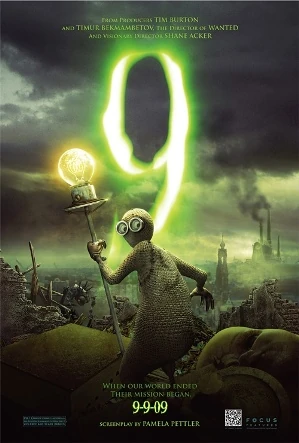
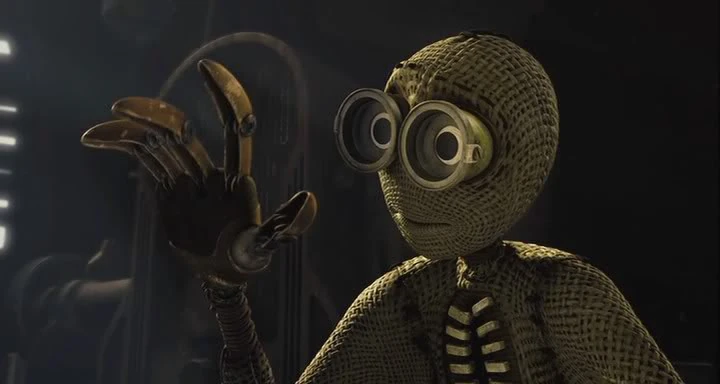

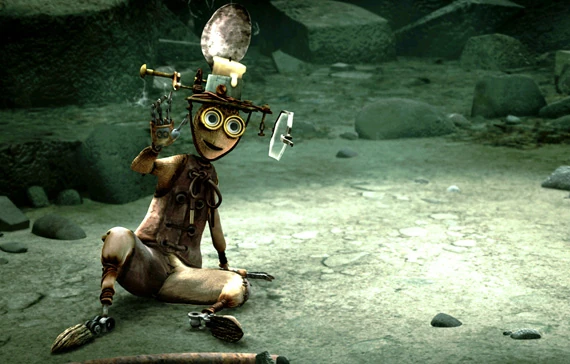



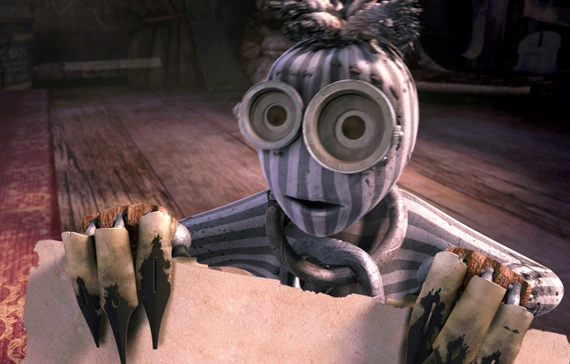

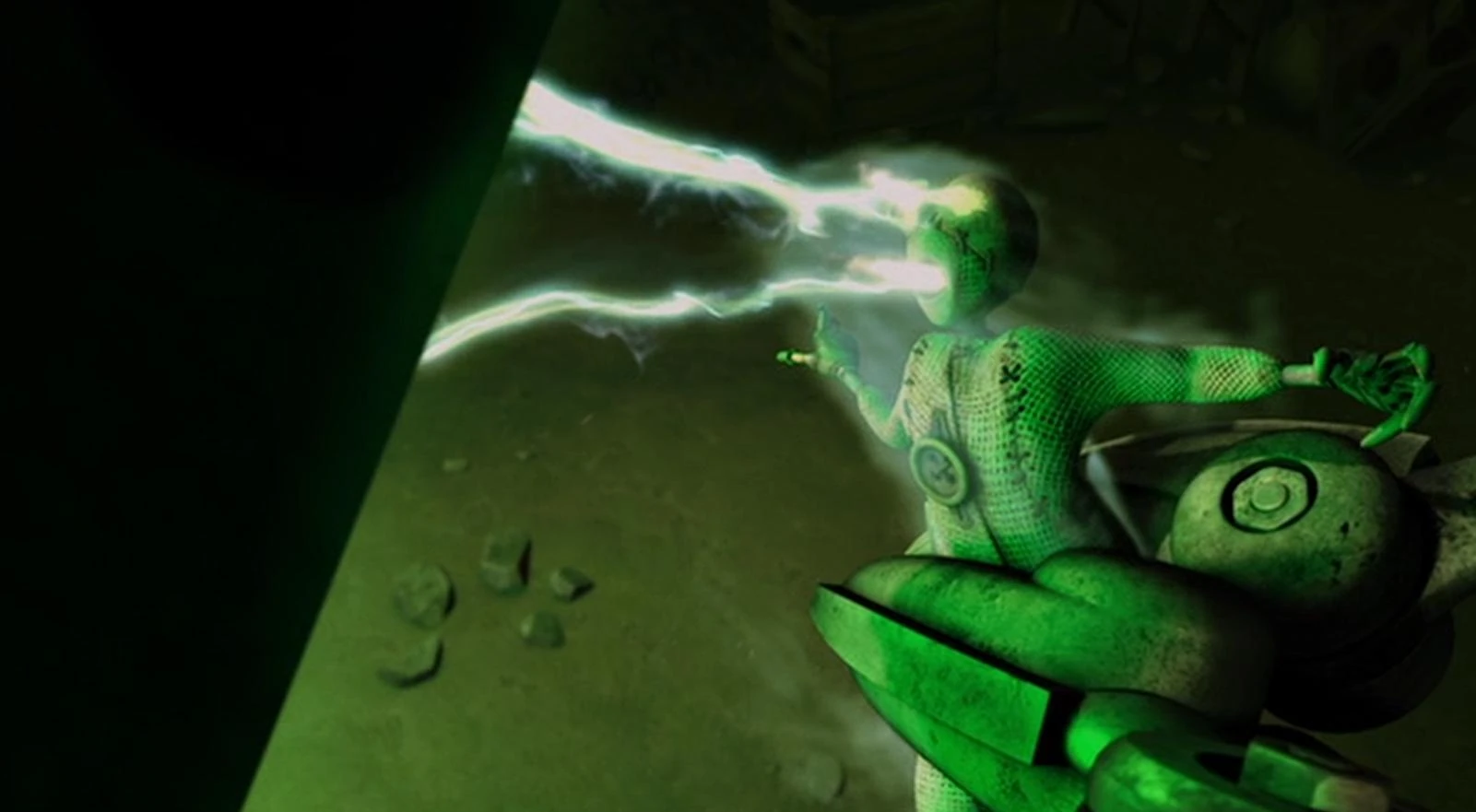
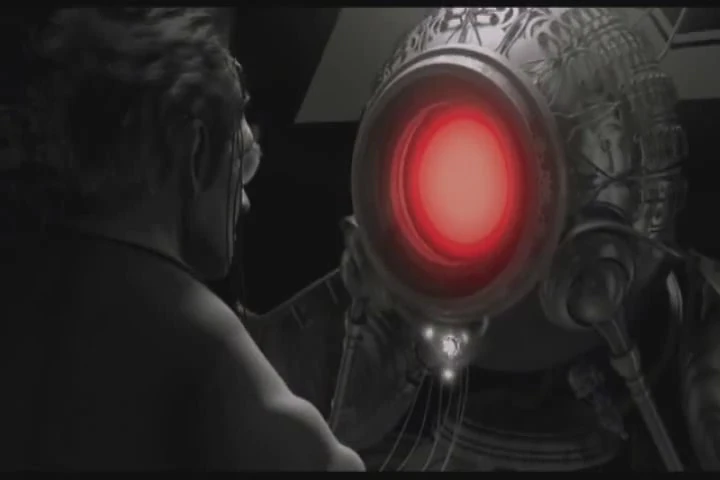

No comments:
Post a Comment